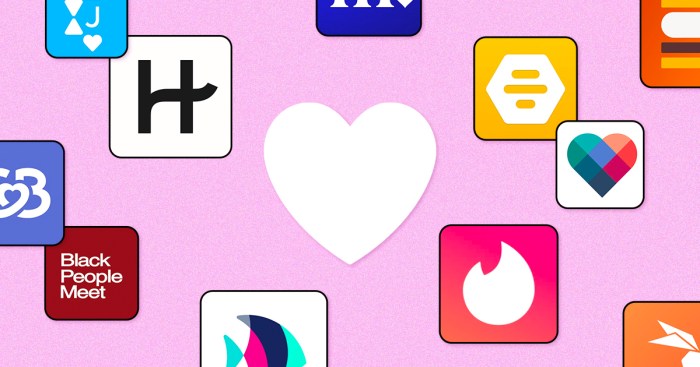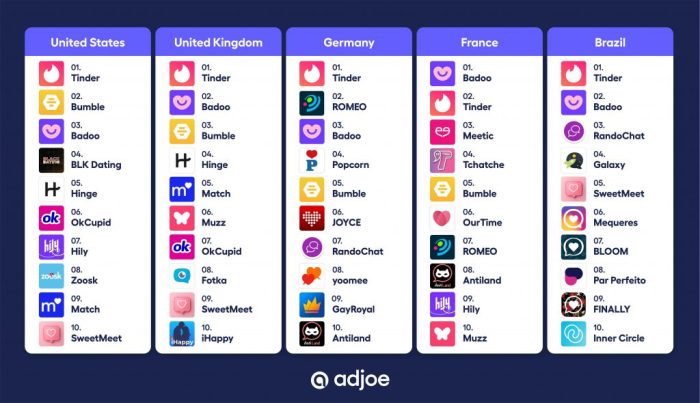Navigating the world of American dating apps can feel like venturing into a digital jungle. From the ubiquitous Tinder to niche platforms catering to specific interests, the sheer variety can be overwhelming. This review delves into the popularity, features, user experiences, safety concerns, and monetization strategies of leading American dating apps, providing a comprehensive overview for both seasoned users and newcomers alike. We'll compare giants like Tinder and Bumble with smaller, more specialized apps, examining their strengths, weaknesses, and the overall impact they have on modern dating.
We'll explore the user interfaces, analyze marketing tactics, and investigate safety measures, highlighting both positive and negative user experiences. This in-depth analysis aims to equip readers with the knowledge to make informed choices and navigate the complexities of online dating safely and effectively. Ultimately, we aim to provide a clear picture of the current landscape, revealing both the opportunities and challenges presented by the ever-evolving world of American dating apps.
Popularity and Features of Top American Dating Apps
The American dating app landscape is a vibrant and competitive ecosystem, with numerous platforms vying for users' attention. Understanding the features, user bases, and pricing models of the most popular apps is crucial for both users seeking a partner and developers aiming to create successful new platforms. This section will analyze the leading apps, highlighting their strengths and weaknesses, and explore the unique offerings of niche dating apps.Comparison of Tinder, Bumble, and Hinge
Tinder, Bumble, and Hinge represent three distinct approaches to online dating, each catering to different user preferences and demographics. Their user interfaces, features, and target audiences contribute significantly to their varying levels of popularity.| App Name | Key Features | User Demographics | Pricing Model |
|---|---|---|---|
| Tinder | Swipe-based matching, Super Likes, Boosts, Passport, detailed profiles | Broad age range, diverse interests, generally considered more casual dating | Freemium; offers paid subscriptions for enhanced features |
| Bumble | Women initiate contact, BFF mode for platonic connections, Bumble Boost for enhanced visibility | Skews slightly towards younger users, emphasis on empowering women | Freemium; offers paid subscriptions for enhanced features |
| Hinge | Focus on meaningful connections, detailed prompts for profile building, emphasizes relationship-oriented dating | Slightly older user base, more focused on long-term relationships | Freemium; offers paid subscriptions for enhanced features |
Unique Selling Propositions of Niche Dating Apps
Several niche dating apps have carved out successful positions by catering to specific demographics or interests. These apps demonstrate the power of specialization in a crowded market. Understanding their unique value propositions provides insights into untapped market segments.Examples of niche dating apps and their unique selling propositions include:
- EliteSingles: Focuses on educated singles seeking long-term relationships, employing a compatibility matching algorithm based on personality and values. This caters to a specific demographic seeking deeper connections.
- JSwipe: Designed for Jewish singles, providing a community-focused environment where users can connect with others sharing their religious and cultural background. This addresses the need for connection within a specific religious community.
- FarmersOnly: Specifically targets individuals in rural areas and those involved in agriculture, creating a dating space where shared lifestyles and values are understood and appreciated. This caters to a specific professional and geographic niche.
Hypothetical Dating App Feature: "Authenticity Verification"
A common complaint about dating apps is the prevalence of fake profiles and catfishing. To address this, a hypothetical feature called "Authenticity Verification" could be implemented. This feature would allow users to verify their identity through various methods, such as linking their social media accounts (with user consent and privacy controls), providing government-issued ID (with robust security measures to prevent data breaches), or completing a video verification process. The app would then display a verified badge on the profiles of those who successfully complete the verification process. This feature would target all users, especially those prioritizing safety and genuine connections. The verification process would be optional but highly encouraged, with verified users potentially receiving enhanced visibility or other benefits.User Experiences and Safety Concerns

Source: purewow.net
Anecdotal Evidence of User Experiences
User reviews and personal accounts offer valuable insights into the realities of using dating apps. The experiences vary greatly, depending on the platform, individual user behavior, and a degree of luck. The following bullet points categorize anecdotal evidence by app, highlighting both positive and negative aspects.- Tinder: Positive experiences often cite the app's ease of use and large user base, leading to quick matches and potential connections. Negative experiences frequently involve encountering fake profiles, receiving unsolicited explicit content, or experiencing ghosting (sudden cessation of communication).
- Bumble: Positive feedback emphasizes the empowering aspect of women initiating contact, leading to more respectful interactions. Negative experiences include the app's potentially slower pace due to the women-first approach and occasional difficulties in finding matches.
- Hinge: Hinge is often praised for its focus on meaningful connections, with users reporting more in-depth profiles and higher-quality interactions. However, some users find the app's more deliberate approach to be slower than other apps, and the algorithm may not always produce suitable matches.
Safety Measures Implemented by Dating Apps
Dating apps are increasingly incorporating safety features to mitigate risks| Feature | Tinder | Bumble | Hinge |
|---|---|---|---|
| Photo Verification | Yes | Yes | Yes |
| Background Checks | No | No (limited third-party integrations) | No |
| Reporting Mechanisms | Yes, robust system | Yes, robust system with clear escalation paths | Yes, user-friendly reporting system |
| Emergency Contact Features | No | No | No |
| Blocking and Unmatching | Yes | Yes | Yes |
Areas for Improvement in User Safety
While dating apps have implemented various safety measures, significant room for improvement remains. Developers should prioritize enhancements in several key areas.- Enhanced Profile Verification: Implementing more rigorous profile verification processes, potentially including ID verification and social media cross-referencing, could significantly reduce the prevalence of fake profiles.
- Integration with Safety Networks: Partnering with safety networks or emergency services to provide direct access to assistance for users experiencing harassment or distress could greatly enhance safety.
- Proactive Moderation: Investing in more sophisticated AI-powered moderation tools to identify and remove abusive content or profiles more effectively is crucial. This should include better detection of hate speech, scams, and explicit content.
- Improved Data Privacy: Strengthening data privacy measures and ensuring transparent data handling practices are essential to build user trust and prevent misuse of personal information.
Marketing and Monetization Strategies

Source: adjoe.io
Marketing and monetization are intrinsically linked; a successful marketing campaign drives user acquisition, which in turn fuels revenue generation through various monetization models. This section will analyze the marketing strategies of two leading apps, compare their monetization models, and propose a new marketing campaign targeting a specific demographic.
Marketing Strategies of Leading Dating Apps
Two prominent players in the American dating app market, Tinder and Bumble, employ distinctly different marketing strategies, reflecting their target audiences and brand identities. Their approaches highlight the diverse avenues available for attracting users.
- Tinder: Tinder's marketing emphasizes its widespread popularity and ease of use. Their campaigns often feature visually appealing imagery and short, catchy slogans focusing on the speed and simplicity of connecting with others. They leverage social media heavily, particularly Instagram and TikTok, using influencer marketing and targeted advertising to reach broad demographics. They also utilize strategic partnerships with other brands and events to increase brand visibility.
- Bumble: Bumble, positioning itself as a platform promoting female empowerment, employs a marketing strategy emphasizing safety, respect, and female agency. Their campaigns often showcase real user stories and focus on building a positive and inclusive community. While they also use social media, their messaging is more nuanced and targeted towards a demographic seeking a more respectful and empowering dating experience. They may prioritize partnerships with organizations promoting women's rights and gender equality.
Monetization Models in Dating Apps
Dating apps utilize a variety of monetization models, often employing a combination of strategies to maximize revenue. The most common methods include subscriptions, in-app purchases, and advertising.
| App | Subscription Model | In-App Purchases | Advertising |
|---|---|---|---|
| Tinder | Tinder Plus, Tinder Gold, Tinder Platinum (varying features and pricing tiers) | Boost (increased visibility), Super Likes (increased chances of matching) | Limited, primarily focused on brand partnerships |
| Bumble | Bumble Boost, Bumble Premium (similar to Tinder's tiered subscriptions) | SuperSwipes (similar to Tinder's Super Likes) | Limited, prioritizing brand alignment with their values |
| Hinge | Hinge Preferred (limited features, no ads) | Limited; primarily focused on subscription features | Minimal to none; Hinge prioritizes a less cluttered user experience |
| OkCupid | OkCupid A-List (enhanced features) | Boost (increased visibility) | Some advertising, but less prominent than other apps |
Proposed Marketing Campaign: "Find Your Tribe" - Targeting LGBTQ+ Singles
This campaign aims to attract LGBTQ+ singles to a fictional dating app, "ConnectU," by emphasizing community and shared experiences. It will focus on building a safe and inclusive space for connection.
Message: "Find Your Tribe. ConnectU: Where belonging begins." The campaign will showcase diverse LGBTQ+ individuals in authentic and relatable scenarios, highlighting the app's features promoting inclusivity and safety.
Channels: The campaign will utilize a multi-channel approach, including:
- Social Media: Targeted advertising on Instagram, TikTok, and Facebook, focusing on LGBTQ+-centric communities and influencers.
- Partnerships: Collaborations with LGBTQ+ organizations and events, sponsoring Pride parades and related initiatives.
- Influencer Marketing: Engaging LGBTQ+ influencers and content creators to promote the app authentically.
- Podcast Advertising: Targeted advertising on podcasts popular within the LGBTQ+ community.
Budget: A $500,000 budget will be allocated across the various channels, with a significant portion dedicated to social media advertising and influencer partnerships. This budget will allow for a robust and impactful campaign reaching a substantial segment of the target demographic.